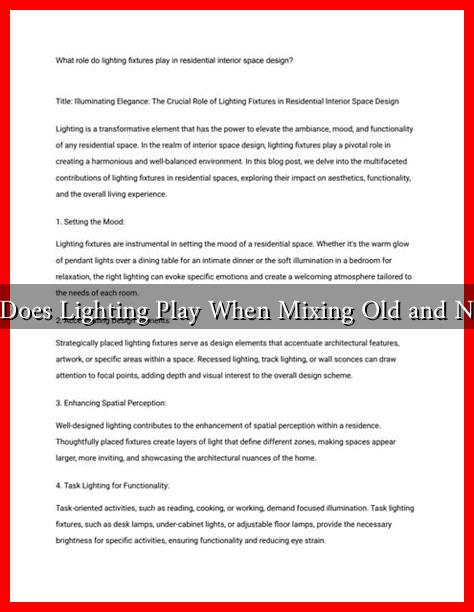-
Table of Contents
What Role Does Lighting Play When Mixing Old and New Design?
In the world of interior design, the juxtaposition of old and new elements can create a captivating aesthetic that tells a story. However, achieving harmony between these contrasting styles requires careful consideration, particularly when it comes to lighting. Lighting not only illuminates a space but also sets the mood, highlights architectural features, and enhances the overall design narrative. This article explores the pivotal role of lighting in blending old and new design elements, offering insights, examples, and practical tips for achieving a cohesive look.
The Importance of Lighting in Design
Lighting is often referred to as the “fifth wall” in interior design, and for good reason. It can transform a space, influencing how colors are perceived and how textures are highlighted. When mixing old and new design, lighting serves several critical functions:
- Creating Atmosphere: The right lighting can evoke emotions and set the tone of a room. Warm, soft lighting can create a cozy, inviting atmosphere, while bright, cool lighting can energize a space.
- Highlighting Features: Strategic lighting can draw attention to architectural details, artwork, or vintage furniture, ensuring that these elements shine in their best light.
- Defining Spaces: In open-concept designs, lighting can help delineate different areas, making it easier to navigate between old and new elements.
Types of Lighting to Consider
When mixing old and new design, it’s essential to consider various types of lighting, each serving a unique purpose:
- Ambient Lighting: This is the general illumination of a space. It can be achieved through ceiling fixtures, wall sconces, or floor lamps. For a harmonious blend, consider using vintage-style fixtures in modern spaces or sleek, contemporary designs in traditional settings.
- Task Lighting: This type of lighting is focused on specific areas where activities take place, such as reading or cooking. Incorporating modern task lighting, like LED desk lamps, can complement vintage furniture while providing functionality.
- Accent Lighting: Accent lighting is used to highlight specific features, such as artwork or architectural details. Using spotlights or track lighting can effectively showcase a mix of old and new elements.
Case Studies: Successful Blends of Old and New
Several designers have successfully navigated the challenge of mixing old and new design through innovative lighting solutions:
- The High Line Hotel, New York: This hotel features a blend of historic architecture and modern design. The use of vintage chandeliers alongside contemporary LED fixtures creates a unique atmosphere that honors the building’s history while embracing modernity.
- Restoration Hardware Gallery, San Francisco: This space showcases a mix of antique and modern furniture. The strategic use of warm, ambient lighting enhances the vintage pieces while providing a contemporary backdrop that feels cohesive.
Practical Tips for Mixing Old and New Design with Lighting
To effectively mix old and new design elements using lighting, consider the following tips:
- Choose a Unifying Color Temperature: Aim for a consistent color temperature across all lighting sources. Warmer tones can soften modern elements, while cooler tones can add a contemporary edge to vintage pieces.
- Layer Your Lighting: Use a combination of ambient, task, and accent lighting to create depth and interest. This layering can help bridge the gap between old and new styles.
- Incorporate Dimmers: Dimmers allow you to adjust the intensity of light, making it easier to create the desired atmosphere for different occasions.
Conclusion
Lighting plays a crucial role in the successful integration of old and new design elements. By understanding the different types of lighting and their functions, designers can create spaces that are not only visually appealing but also emotionally resonant. The right lighting can highlight the beauty of vintage pieces while ensuring that modern elements feel at home. As you embark on your design journey, remember that lighting is not just about illumination; it’s about crafting an experience that celebrates the past while embracing the future.
For more insights on lighting and design, consider exploring resources like Architectural Digest or Dwell.

